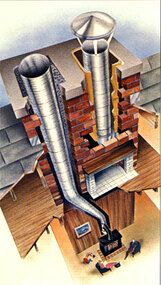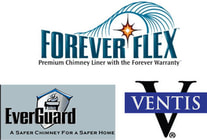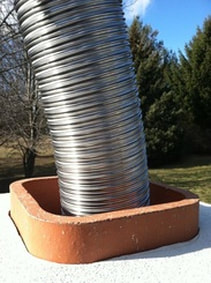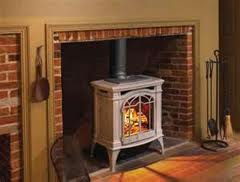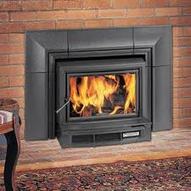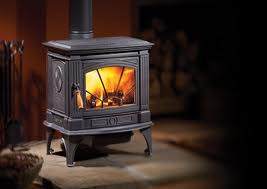Chimney Lining
What is a chimney liner?
Chimney liners are metal venting channels that can either be flexible or rigid, depending on the necessity of the chimney.
Why is relining necessary?
Traditional clay tile flues tend to break down and corrode over time. In heating appliances that use oil, the deposits in the flue become acidic when mixed with water, accelerating deterioration. Liners are designed to maintain an insulated vent from the furnace, or appliances through the chimney. Chimney liners provide an extra layer of protection between the inside of the chimney and the framing of your home.
In many cases, older homes have unlined chimneys which increase the risk of carbon monoxide and combustion fumes leaking into the house. Relining provides an air tight, vapor tight, enclosure to guide the fumes safely out of the home.
Improper construction, such as poorly laid tiles, can cause performance and maintenance problems. Clay tile liners should be set squarely one upon the other and properly mortared. Poor construction can leave a brand new chimney in poor condition. Settling, storms, wind damage, soil erosion, lightning strikes, poor maintenance, creosote and soot penetration and numerous other occurrences can create conditions that will dictate a new liner.
In many cases, older homes have unlined chimneys which increase the risk of carbon monoxide and combustion fumes leaking into the house. Relining provides an air tight, vapor tight, enclosure to guide the fumes safely out of the home.
Improper construction, such as poorly laid tiles, can cause performance and maintenance problems. Clay tile liners should be set squarely one upon the other and properly mortared. Poor construction can leave a brand new chimney in poor condition. Settling, storms, wind damage, soil erosion, lightning strikes, poor maintenance, creosote and soot penetration and numerous other occurrences can create conditions that will dictate a new liner.
Would a fireplace chimney need a liner?
Yes. Any chimney can and should be lined. Wood Stoves in particular now require an insulated liner as part of recent changes in fire safety codes.
why do you need a certified chimney technician to install a liner?
Our technicians attend training seminars offered by liner manufacturers to properly install their liners. Once it's determined a chimney has to be relined, several factors come into place to determine size and type of liner, which depends on what the appliance uses for fuel and the appliance's efficiency. Modern gas units are much more efficient than they were decades ago and call for a smaller exhaust passage to keep condensation to a minimum.
Paul's Chimney Cleaning & Restoration, LLC provides and install the best available stainless steel relining systems backed by UL listing installation guidelines and a lifetime warranty.
Paul's Chimney Cleaning & Restoration, LLC provides and install the best available stainless steel relining systems backed by UL listing installation guidelines and a lifetime warranty.
what is spalling and what can it cause?
Spalling occurs when chips of clay tile or brick exfoliate, break off and crumble due to moisture deterioration. Inside of the chimney, these little bits of material not only reduce the thickness (and protective ability) of your chimney liner, the pieces drop down and settle somewhere, often causing a blockage. Spalling damage can occur to both the inside and the outside of a chimney.
Spalling is particularly worrisome with chimneys venting gas or oil, such as water heaters and furnaces. These appliances vent through a hole in the wall, called the thimble, and spalled material can accumulate to block this passageway. A chimney that doesn't vent properly will allow carbon monoxide, soot, and deadly fumes to back up into the house's interior.
Spalling is an incremental problem; the longer this condition exists, the more the deterioration will accelerate. A new chimney liner, especially a stainless steel liner, will solve spalling problems related to the appliance venting.
Spalling is particularly worrisome with chimneys venting gas or oil, such as water heaters and furnaces. These appliances vent through a hole in the wall, called the thimble, and spalled material can accumulate to block this passageway. A chimney that doesn't vent properly will allow carbon monoxide, soot, and deadly fumes to back up into the house's interior.
Spalling is an incremental problem; the longer this condition exists, the more the deterioration will accelerate. A new chimney liner, especially a stainless steel liner, will solve spalling problems related to the appliance venting.
Wood Stoves
What is a wood stove?
Wood Stoves are an efficient way to heat your home, coming in three forms: Hearth, Insert, and Free-Standing
WHY SHOULD YOU GET YOUR WOOD STOVE CHECKED YEARLY?
Wood stoves are prone to creosote accumulation. Creosote is a byproduct of combustion that accumulates as smoke particles cool inside the flue. Without regular sweepings and inspections, creosote can build up enough to choke the flue, but the real danger lies in its flammability.
An epidemic of house-fires, caused by poorly installed wood stoves, prompted the adoption of strict building and fire codes to ensure safety. These include clearances, proper venting, and even the installation of insulated stainless steel liners, and venting components, as well as roof kit installations.
An epidemic of house-fires, caused by poorly installed wood stoves, prompted the adoption of strict building and fire codes to ensure safety. These include clearances, proper venting, and even the installation of insulated stainless steel liners, and venting components, as well as roof kit installations.
Fireplaces and Fires
why is fireplace maintenance important?
When a chimney is used, soot and tiny particles of unburned carbon and wood tar vapors called creosote, collect on the inside of the chimney walls. Average use, as little as one or two years will allow the buildup of these deposits to reach dangerous levels. When creosote gets hot enough, it will ignite a chimney fire.
A chimney fire is extremely dangerous. In many cases, it will destroy the chimney and spread to the rest of the home. Every year, thousands of homes are destroyed this way. It's a situation that can be avoided with regular inspections and maintenance done by a chimney professional.
A chimney fire is extremely dangerous. In many cases, it will destroy the chimney and spread to the rest of the home. Every year, thousands of homes are destroyed this way. It's a situation that can be avoided with regular inspections and maintenance done by a chimney professional.
What can a chimney fire damage?
In the old days, folks used to think that purposely igniting a chimney fire was the best way to clean out the chimney. This was a dangerous practice that led to untold house fires. Unlike fireplaces, clay tile liners are designed to vent flue gases, not a fire. Rapidly rising high temperatures during a chimney fire will typically damage the flue tiles. Combustibles surrounding the chimney like roof framing, walls, etc., can overheat and ignite.

